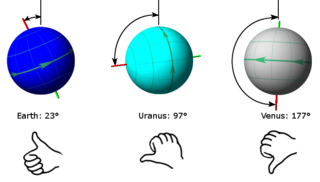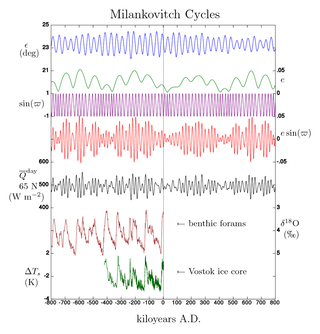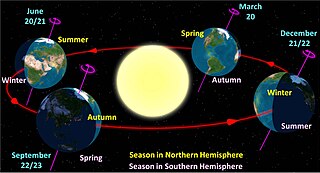Related Research Articles

The ecliptic or ecliptic plane is the orbital plane of Earth around the Sun. From the perspective of an observer on Earth, the Sun's movement around the celestial sphere over the course of a year traces out a path along the ecliptic against the background of stars. The ecliptic is an important reference plane and is the basis of the ecliptic coordinate system.

In celestial mechanics, an orbit is the curved trajectory of an object such as the trajectory of a planet around a star, or of a natural satellite around a planet, or of an artificial satellite around an object or position in space such as a planet, moon, asteroid, or Lagrange point. Normally, orbit refers to a regularly repeating trajectory, although it may also refer to a non-repeating trajectory. To a close approximation, planets and satellites follow elliptic orbits, with the center of mass being orbited at a focal point of the ellipse, as described by Kepler's laws of planetary motion.

Precession is a change in the orientation of the rotational axis of a rotating body. In an appropriate reference frame it can be defined as a change in the first Euler angle, whereas the third Euler angle defines the rotation itself. In other words, if the axis of rotation of a body is itself rotating about a second axis, that body is said to be precessing about the second axis. A motion in which the second Euler angle changes is called nutation. In physics, there are two types of precession: torque-free and torque-induced.

Tidal acceleration is an effect of the tidal forces between an orbiting natural satellite and the primary planet that it orbits. The acceleration causes a gradual recession of a satellite in a prograde orbit away from the primary, and a corresponding slowdown of the primary's rotation. The process eventually leads to tidal locking, usually of the smaller body first, and later the larger body. The Earth–Moon system is the best-studied case.

In astronomy, axial precession is a gravity-induced, slow, and continuous change in the orientation of an astronomical body's rotational axis. In the absence of precession, the astronomical body's orbit would show axial parallelism. In particular, axial precession can refer to the gradual shift in the orientation of Earth's axis of rotation in a cycle of approximately 26,000 years. This is similar to the precession of a spinning top, with the axis tracing out a pair of cones joined at their apices. The term "precession" typically refers only to this largest part of the motion; other changes in the alignment of Earth's axis—nutation and polar motion—are much smaller in magnitude.

In astronomy, axial tilt, also known as obliquity, is the angle between an object's rotational axis and its orbital axis, which is the line perpendicular to its orbital plane; equivalently, it is the angle between its equatorial plane and orbital plane. It differs from orbital inclination.

The orbital period is the amount of time a given astronomical object takes to complete one orbit around another object. In astronomy, it usually applies to planets or asteroids orbiting the Sun, moons orbiting planets, exoplanets orbiting other stars, or binary stars. It may also refer to the time it takes a satellite orbiting a planet or moon to complete one orbit.
In astronomy, an epoch or reference epoch is a moment in time used as a reference point for some time-varying astronomical quantity. It is useful for the celestial coordinates or orbital elements of a celestial body, as they are subject to perturbations and vary with time. These time-varying astronomical quantities might include, for example, the mean longitude or mean anomaly of a body, the node of its orbit relative to a reference plane, the direction of the apogee or aphelion of its orbit, or the size of the major axis of its orbit.

Milankovitch cycles describe the collective effects of changes in the Earth's movements on its climate over thousands of years. The term was coined and named after Serbian geophysicist and astronomer Milutin Milanković. In the 1920s, he hypothesized that variations in eccentricity, axial tilt, and precession combined to result in cyclical variations in the intra-annual and latitudinal distribution of solar radiation at the Earth's surface, and that this orbital forcing strongly influenced the Earth's climatic patterns.
A synodic day is the period for a celestial object to rotate once in relation to the star it is orbiting, and is the basis of solar time.

Earth orbits the Sun at an average distance of 149.60 million km in a counterclockwise direction as viewed from above the Northern Hemisphere. One complete orbit takes 365.256 days, during which time Earth has traveled 940 million km. Ignoring the influence of other Solar System bodies, Earth's orbit, also known as Earth's revolution, is an ellipse with the Earth-Sun barycenter as one focus with a current eccentricity of 0.0167. Since this value is close to zero, the center of the orbit is relatively close to the center of the Sun.

In astronomy, perturbation is the complex motion of a massive body subjected to forces other than the gravitational attraction of a single other massive body. The other forces can include a third body, resistance, as from an atmosphere, and the off-center attraction of an oblate or otherwise misshapen body.

The proper orbital elements or proper elements of an orbit are constants of motion of an object in space that remain practically unchanged over an astronomically long timescale. The term is usually used to describe the three quantities:

The Moon orbits Earth in the prograde direction and completes one revolution relative to the Vernal Equinox and the stars in about 27.32 days and one revolution relative to the Sun in about 29.53 days. Earth and the Moon orbit about their barycentre, which lies about 4,670 km (2,900 mi) from Earth's centre, forming a satellite system called the Earth–Moon system. On average, the distance to the Moon is about 385,000 km (239,000 mi) from Earth's centre, which corresponds to about 60 Earth radii or 1.282 light-seconds.
The semi-analytic planetary theory VSOP is a mathematical model describing long-term changes in the orbits of the planets Mercury to Neptune. The earliest modern scientific model considered only the gravitational attraction between the Sun and each planet, with the resulting orbits being unvarying Keplerian ellipses. In reality, all the planets exert slight forces on each other, causing slow changes in the shape and orientation of these ellipses. Increasingly complex analytical models have been made of these deviations, as well as efficient and accurate numerical approximation methods.
The stability of the Solar System is a subject of much inquiry in astronomy. Though the planets have been stable when historically observed, and will be in the short term, their weak gravitational effects on one another can add up in unpredictable ways.

In celestial mechanics, apsidal precession is the precession of the line connecting the apsides of an astronomical body's orbit. The apsides are the orbital points farthest (apoapsis) and closest (periapsis) from its primary body. The apsidal precession is the first time derivative of the argument of periapsis, one of the six main orbital elements of an orbit. Apsidal precession is considered positive when the orbit's axis rotates in the same direction as the orbital motion. An apsidal period is the time interval required for an orbit to precess through 360°, which takes Earth's orbit about 112,000 years, completing a cycle and returning to the same orientation.
A tropical year or solar year is the time that the Sun takes to return to the same position in the sky of a celestial body of the Solar System such as the Earth, completing a full cycle of seasons; for example, the time from vernal equinox to vernal equinox, or from summer solstice to summer solstice. It is the type of year used by tropical solar calendars. The solar year is one type of astronomical year and particular orbital period. Another type is the sidereal year, which is the time it takes Earth to complete one full orbit around the Sun as measured with respect to the fixed stars, resulting in a duration of 20 minutes longer than the tropical year, because of the precession of the equinoxes.
This glossary of astronomy is a list of definitions of terms and concepts relevant to astronomy and cosmology, their sub-disciplines, and related fields. Astronomy is concerned with the study of celestial objects and phenomena that originate outside the atmosphere of Earth. The field of astronomy features an extensive vocabulary and a significant amount of jargon.
Astronomical nutation is a phenomenon which causes the orientation of the axis of rotation of a spinning astronomical object to vary over time. It is caused by the gravitational forces of other nearby bodies acting upon the spinning object. Although they are caused by the same effect operating over different timescales, astronomers usually make a distinction between precession, which is a steady long-term change in the axis of rotation, and nutation, which is the combined effect of similar shorter-term variations.
References
- ↑ "secular (adj.)". Etymology Online.
- ↑ "secular, adj. and n.". Oxford English Dictionary.
- ↑ Jyri B. Kolesnik; Revision of the tidal acceleration of the Moon and the tidal deceleration of the Earth's rotation from historical optical observations of planets, in ISBN 2-901057-45-4 (2001) pp. 231 - 234.
- ↑ Lowrie, William (2004). Fundamentals of Geophysics. Cambridge University Press. ISBN 978-0-521-46164-1.
- ↑ Jurij B. Kolesnik; A new approach to interpretation of the non-precessional equinox motion, in Journées 2000 - systèmes de référence spatio-temporels. J2000, a fundamental epoch for origins of reference systems and astronomical models, Paris, Septembre 2000, edited by N. Capitaine, Observatoire de Paris (2001), pp. 119 – 120. ISBN 2-901057-45-4
- ↑ Bretagnon, P. (1982). "Théorie du mouvement de l'ensemble des planètes. Solution VSOP82". Astronomy & Astrophysics . 114: 278–288. Bibcode:1982A&A...114..278B.
- ↑ Edwards, R.; McGee, J.; Bessetti, W. H. C. (2007). Technical Analysis of Stock Trends. CRC Press. p. 17. ISBN 978-0-8493-3772-7.
- ↑ Merrill, Ronald T.; McElhinny, Michael W.; McFadden, Phillip L. (1996). The Magnetic Field of the Earth: Paleomagnetism, the Core, and the Deep Mantle. International Geophysics Series. Vol. 63. Academic Press. ISBN 9780124912458.
- ↑ Okasha, M; McCarron, P; McEwen, J; Smith, GD (2001). "Age at menarche: secular trends and association with adult anthropometric measures". Annals of Human Biology . 28 (1): 68–78. doi:10.1080/03014460150201896. PMID 11201332.
- ↑ Wattigney, WA; Srinivasan, SR; Chen, W; Greenlund, KJ; Berenson, GS (1999). "Secular trend of earlier onset of menarche with increasing obesity in black and white girls: the Bogalusa Heart Study". Ethnicity & Disease. 9 (2): 181–189. PMID 10421080.
- ↑ Prentice, S; Fulford, AJ; Jarjou, LM; Goldberg, GR; Prentice, A (2010). "Evidence for a downward secular trend in age of menarche in a rural Gambian population". Annals of Human Biology . 37 (5): 717–721. doi:10.3109/03014461003727606. PMC 3575631 . PMID 20465526.
- ↑ Biro, Frank; Galvez, MP; Greenspan, LC; Succop, PA; Vangeepuram, N (Sep 2010), "Pubertal assessment method and baseline characteristics in a mixed longitudinal study of girls", Pediatrics, 126 (3): e583–90, doi:10.1542/peds.2009-3079, PMC 4460992 , PMID 20696727
- ↑ Euling, Susan; Herman-Giddens, Marcia; Lee, Peter; Selevan, Sherry (February 2008). "Examination of US Puberty-Timing Data from 1940 to 1994 for Secular Trends: Panel Findings". Pediatrics. 121 (3).